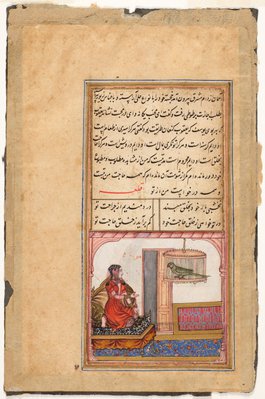Title
A parrot talking to a woman; a folio from the Tutinama
circa 1580
Artist
-
Details
- Place where the work was made
-
North India
→
India
- Date
- circa 1580
- Media category
- Painting
- Materials used
- opaque watercolour on paper
- Dimensions
- 45.8 x 31.8 cm frame
- Credit
- Gift of Dr Jim Masselos 2022
- Location
- Not on display
- Accession number
- 63.2022
- Copyright
- Artist information
-
Imperial Mughal from the workshop of Emperor Akbar
Works in the collection
- Share
-
-
About
The Tutinama (Tales of the Parrot) is a collection of 52 moralising stories compiled by the Persian physician and Sufi, Ziya ‘Ud-din Nakshahbi, around 1329-30 CE while he was living in India. Based on an earlier Persian translation of a Sanskrit text known Sukasapati ( 70 tales of a parrot) they are about the merchant Mainum who leaves his dedicated pet myna bird and parrot at home to provide company for his wife Khajasta while he is away on business. In her husband’s absence, Khajasta becomes lonely and seeks a lover but both birds protest and advise her against this. Angered, the wife kills the Myna bird and the parrot intent on saving its own life and preserving its master’s honour makes-up a series of engaging stories to keep Khajasta busy over the next 52 nights. The Mughal emperor Akbar (r. 1156- 1605) enjoyed these stories so much he commissioned two illustrated manuscripts for his library. One manuscript survives almost entirely intact as part of the collection of the Cleveland Museum of Art, United States. The other manuscript from which this folio originates is known as the Chester Beatty Library (Dublin) manuscript, where a large proportion, including 143 folios and 102 miniature paintings remain together. Although originally commissioned by Emperor Akbar and compiled into a single album, many of the folios illustrating the different fables show the work of different artists and calligraphers.
-
Exhibition history
Shown in 1 exhibition
Intimate Encounters: Indian paintings from Australian collections, Art Gallery of New South Wales, Sydney, 22 Feb 2007–04 May 2007
-
Bibliography
Referenced in 1 publication
-
Fine Oriental Manuscripts and Miniatures, London, Nov 1986. lot. 16
-

